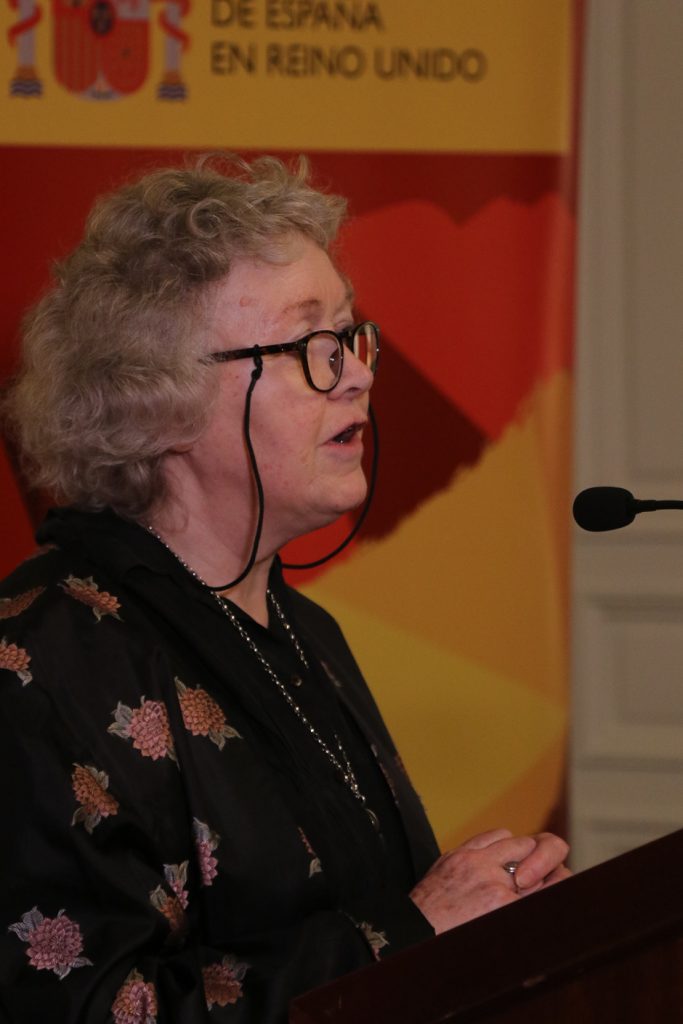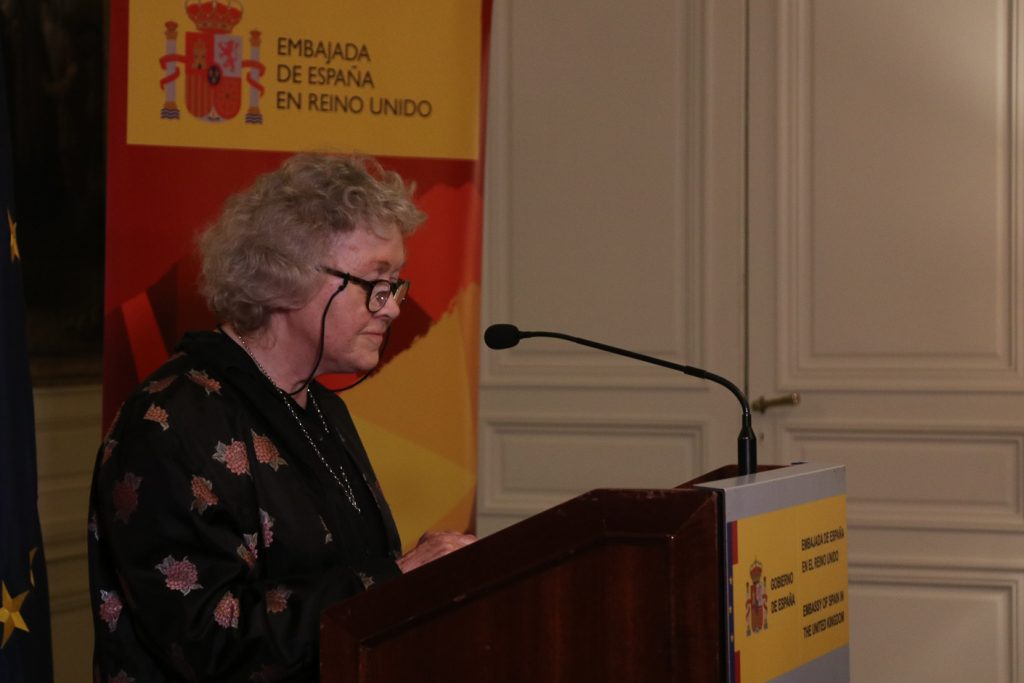Translator Anna Crowe on Margarit’s poetry

Translator Anna Crowe is the co-founder of StAnza, Scotland’s Poetry Festival, her translations of the late Catalan poet, Joan Margarit, brought her a Society of Authors Travelling Scholarship in 2005. Margarit’s two final collections were published in November 2021 by Bloodaxe Books as Wild Creature. Bloodaxe have published three previous collections of his work, Tugs in the fog (awarded a Recommendation for translation in 2006 by the Poetry Book Society), Strangely Happy and Love is a Place. She has translated several books for Arc Publications: an anthology of Catalan poetry (Six Catalan Poets, Arc, 2013); a collection by the Mexican poet, Pedro Serrano (Peatlands, Arc Publications 2014); a collection of work by the Mallorcan poet Josep-Lluís Aguiló, (Lunarium, 2016); and a collection by the Catalan poet Manuel Forcano (Maps of Desire, Arc 2019), awarded a PBS Recommendation.
Crowe is the co-founder of StAnza, Scotland’s International Poetry Festival and served as Artistic Director for the first seven years, from 1998 – 2005, and subsequently on the Board of Trustees. Her poetry has been translated and anthologised, and recorded for the Poetry Archive. Figure in a Landscape was written in memory of her sister, and in collaboration with the Mallorcan artist, Andreu Maimó. It was published by Mariscat Press, and in a bilingual illustrated edition by Ensiola in Mallorca, and received the Calum MacDonald Award and was a Poetry Book Society Choice; her third full collection is Not on the Side of the Gods (Arc, 2019) and was described the poet, Stewart Conn, as offering ‘an illuminating insight into the marvels of an uncanny links between the natural world and its creatures, and the shifts of light and shade in our own lives’. She is at present working on another collaborative book with Andreu Maimó, to be called Words on the Wind/Paraules al Vent, to be published by Ensiola. She was born in Plymouth, went to school in Marseille and Sussex, and read French and Spanish at the University of St Andrews, where she lives with her husband, Dr Julian Crowe. They have three children and five grandchildren.
- How would you describe Margarit poetry?

I would describe JM’s poetry as unflinchingly honest. Grief and loss are confronted courageously. He himself described his poetry to me as ‘harsh, rough, even hard’, but there is always a warmth and humanity running through it. He had no time for mystification, especially the religious kind. As he says in ‘Reasons and ways’, ‘I value what’s real: iron when it was being forged/into a nail or a plough, any feeling that I/can recognise in a clean and clear shape.’
His poetry reveals a great love and understanding of music and art, of Schubert, JS Bach, Mozart, Beethoven, Shostakovich, the French chansonniers such as Jacques Brel, Léo Ferré, Geurges Brassens, and all the great jazz musicians.
Van Gogh’s work he loved: ‘Painter of firmaments, clogs, beds, chairs/and fields of wheat that crows fly over.’ Brueghel and Hokusai, Lucian Freud, Francis Bacon, Paula Rego – all painters who paint the everyday, the disturbing, dirty, seamy side of life – these he admired. And the same goes for other poets, such as Philip Larkin, Carles Riba, Josep Carner, Baudelaire, Verlaine, Juan Ramón Jiménez, Elizabeth Bishop, RS Thomas and his beloved Thomas Hardy. Homer, above all. The Iliad is always just below the surface of Margarit’s poems, and his poetry embraces the human experience in all its plurality, strangeness and tragedy.
2. Could you tell us more about the translation process?
Listening to the sounds, the music, of a poem comes first and is of supreme importance. I carry a poem around in my head, living inside it. The translation must reflect the tone of voice, the mood of the original. I check all unfamiliar words to see if there are unsuspected nuances to be aware of. Then I think the poem through in English. The translator, to my way of thinking, should not stand in the way of the poem, or insert his or her own experience into their version. For Margarit’s poetry it has to be clear, straightforward, unpretentious English but should convey something of the rhythms and sounds, wherever possible, of the Catalan. These two languages have a certain affinity, since Catalan, like English, is a consonantal language and has a lot of monosyllabic words and words with masculine endings, so it is not too hard to find equivalent sonic patterns and rhythms. Joan told me, some years ago, ‘I discovered quite early that we sing from the same music, and from that moment on, I ceased to worry.’ He sent me his poems by email and I sent my translations back, and goodness knows how many hundreds, probably several thousands, of emails flew back and forth! He always sent me the Proa editions as soon as they were published, always with affectionate dedications. He would also send the Castilian versions, as he knew my Castilian had been learned before the Catalan and my spoken Castilian was far more fluent than my Catalan, so this was sometimes helpful in decoding an obscure word.
3. What were the biggest challenges during the translation?
The biggest challenge, especially at the beginning, was to make sure the tone was right, and the tone was often brusque and hard. As I have said elsewhere, with poetry like Margarit’s the translator has nowhere to hide. I often felt exposed and that the poetry was almost painfully bare, but the harsher and barer it was, the closer it seemed to get to the bones and the truth of the poem. Another, more amusing, challenge was persuading Joan, from time to time, of the rightness of my choice of English words or expressions unfamiliar to him. He would try to suggest something that would have been absurd or give an unsuitable nuance to the writing. Instead of using a decent dictionary, he would produce from his pocket a little electronic gadget which was a sort of dictionary, but which gave almost no clue as to context, so the suggestions were sometimes hilarious!

4. Is there any special poem that you would like to mention?
One of Margarit’s poems I love best is from Tugs in the fog, and that is ‘Goodbye to Uncle Lluís’, the uncle who died at the Teruel front in the Spanish Civil War, leaving among his few possessions a cassette player that had in it a recording of the song of a nightingale. There is something of the First World War poet, Edward Thomas, another bird-lover, in this poem whose last two lines are
He will never go back to the river
to record the night birds singing.
But from Wild Creature it would have to be ‘In the early morning’. I find this a very moving poem: the poet and his wife are awake and reading, but the poet turns off his light and lies down. He knows the time left to him is now short:
… I know that where I am gazing
we will end up going with bare feet:
these feet of ours that have searched for each other
beneath the sheets for such a long time …
This is an intimate, tender, domestic image, but it does double duty, since it also carries the knowledge of his approaching death, and the poem continues, linking their reading in bed to the ‘headlights on the deux chevaux’, the little car that used to take them long ago
… along tiny roads
in a world without motorways, where we had to
stop for the night when going to Paris.
The poem succeeds in being a love poem and a poem that faces up to death, as well as a poem celebrating memory and the freedom of going to Paris in the dark days of the Francoist dictatorship. We might call it a ‘bobbed sonnet’ since it is a love poem with a volta between lines 8 and 9, but has 13 not 14 lines, something that to me suggests the poet’s approaching death, the cutting short of a life. Here is the poem in full:
IN THE EARLY MORNING
I have turned off my light and lain down.
You go on reading beside me.
What I’m doing is turning my back on the world,
but I know that where I am gazing
we will end up going with bare feet:
these feet of ours that have searched for each other
beneath the sheets for such a long time.
There is no gesture as warm as this.
You and I, reading in bed early in the morning,
we’re like the headlights on the deux chevaux
that used to carry us along tiny roads
in a world without motorways, where we had to
stop for the night when going to Paris.
5. Could you tell us your opinion of the breadth of Margarit’s readership in the United Kingdom?
I believe that Joan Margarit has been widely read by the poetry-reading public in the UK ever since the publication of Tugs in the fog in 2006, and Bloodaxe have of course published three more books (themselves containing two or three of his collections) since then, so sales must have been good! I know that he is greatly admired by poets of the calibre of Kerry Hardie, Paul Durcan, and Moya Cannon in Ireland, by Menna Elfyn, Professor Emerita of Poetry at the University of Wales Trinity St David, and in Scotland by the first Edinburgh Makar, Stewart Conn, and Vicki Feaver, former Professor of Creative Writing at the University of Chichester. Joan and I have read together at many poetry festivals, including here at StAnza (twice), the South Bank Festival (London), at Newcastle University, and at four separate festivals down the years in the Republic of Ireland, namely Dún Laoghaire (attended by Seamus Heaney and Derek Mahon!), Galway, Limerick, and Cork.


